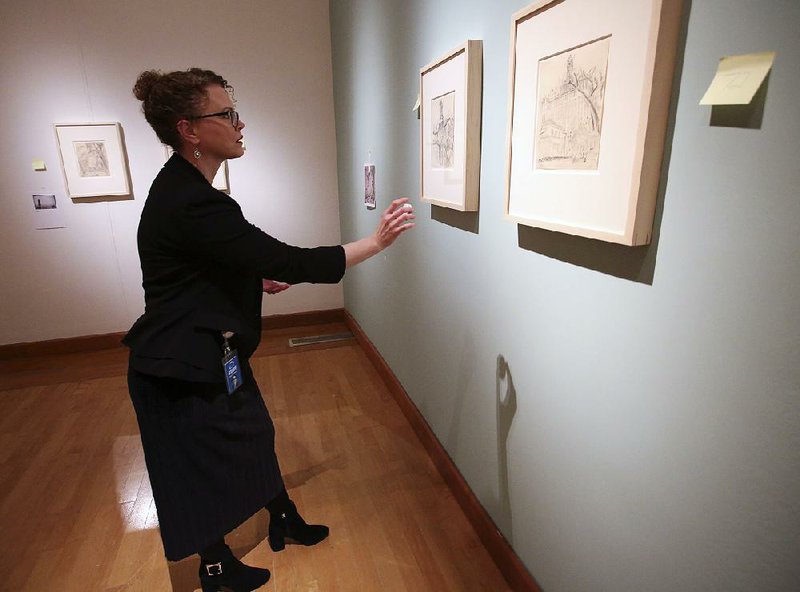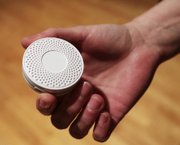The Arkansas Arts Center will unveil its John Marin exhibit today alongside new technology that officials hope will give visitors a fuller viewing experience.
Small sensors installed throughout the gallery will send detailed information about the artist and his work to guests’ cellphones as they walk among Marin’s drawings and paintings.
The foray into “beacon” technology coincides with an exhibition the museum has designed with the intent to demonstrate it has the capacity for significant showings.
“This allows you to access more information without having to put it on the wall or cluttering the experience,” said Angel Galloway, the museum’s communications director and the person who coordinated the project. “I really don’t want you to notice [the sensors], to be honest with you.”
The Arkansas Arts Center’s use of beacons follows similar offerings across the state, including Garvan Woodland Gardens, the Little Rock Zoo and the Fayetteville Roots Festival. In New York, the Solomon R. Guggenheim Museum and Metropolitan Museum of Art also have used the sensors, Galloway said.
“Becoming John Marin: Modernist At Work” relies on 79 pieces from the the Arts Center’s extensive collection of Marin’s work — his daughter-in-law in 2013 donated 290 drawings and watercolors to the museum — as well as 33 pieces loaned by museums such as Crystal Bridges Museum of Modern Art, the National Gallery of Art and others.
Ann Prentice Wagner, the Arts Center’s curator of drawings, spent four years studying Marin in preparation for the exhibition, billed as the first reunion of Marin’s finished watercolors and other paintings with their underlying sketches outside of his studio. Wagner also edited a 430-page accompanying catalog about Marin, who was deemed America’s greatest painter by a 1948 Look magazine survey of artists, curators and critics.
A dozen small, circular beacons are scattered throughout the Marin exhibit to send information about the artwork and the artist. The beacons have a radius of several feet.
One, for example, focuses on the Brooklyn Bridge. It sends to a nearby guest’s phone two paragraphs explaining how the artist used the bridge’s boardwalk as a vantage point to depict the changing Manhattan skyline and a link to more information.
Four more Marin-centric sensors are just outside the gallery in the museum’s atrium. Those welcome visitors to the exhibit, offer a comment form, a trivia question and information on Marin’s contemporaries.
Visitors view the information through a free downloadable smartphone app, Beacon Sage, which relies on a Blue-tooth connection to accept information sent by the sensors. The app allows people to save the information displays so that they can view them after leaving the museum.
The app draws information from a website the Arts Center launched alongside the exhibition, becomingjohnmarin.org. The site includes a timeline of Marin’s life and a digital map showing where, for example, he drew a specific piece. People without smartphones can access the information on a tablet inside the gallery.
Arts Center Executive Director Todd Herman, who praised the beacons as a “great way to give more information and a deeper experience for our visitors,” said the plan is to extend their use beyond the three-month showing.
“There are endless possibilities,” he said.
Aristotle, a Little Rock company focused on Web-based business, developed the Beacon Sage app used by the Arts Center and other Arkansas organizations. Carlos Lee, business development specialist at Aristotle, said the technology emerged about five years ago.
“We feel that we’re going to have an exhibit that’s going to be tailored to fit their needs,” said Lee, who worked directly with the museum ahead of the rollout.
Garvan Gardens, the University of Arkansas botanical garden in Hot Springs, introduced beacons last spring. It uses 25 sensors to link visitors with audio — narrated by a Morgan Freeman sound-alike — and explanatory pictures while they take self-guided tours.
“It enhances the tour because it gives you the story behind what you’re seeing without having to read it on a map,” Garvan Gardens’ marketing director, Sherre Freeman, said.


